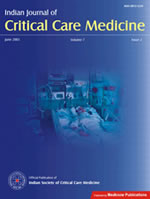
|
Indian Journal of Critical Care Medicine
Medknow Publications on behalf of the Indian Society of Critical Care Medicine
ISSN: 0972-5229
EISSN: 0972-5229
Vol. 9, No. 3, 2005, pp. 137-140
|
 Bioline Code: cm05021
Bioline Code: cm05021
Full paper language: English
Document type: Research Article
Document available free of charge
|
|
|
Indian Journal of Critical Care Medicine, Vol. 9, No. 3, 2005, pp. 137-140
| en |
Evaluation of the door-to-needle time for fibrinolytic administration for acute myocardial infarction
Masurkar VA, Kapadia FN, Shirwadkar CG, Shukla U, Sood P
Abstract
Background: Fibrinolytic therapy has reduced mortality following acute myocardial infarction (AMI) with the major effect coming from early achievement of infarct-related artery patency.
Aim: To evaluate the door-to-needle time for fibrinolytic administration for AMI and to identify factors associated with a prolonged door-to-needle time.
Materials and Methods: Our study was a prospective audit of patients who were thrombolyzed for AMI at our hospital from July 1, 2004 to March 15, 2005. All patients admitted with AMI, who were candidates for fibrinolysis, were included. We recorded the door-to-needle time. Whenever possible, we tried to find out the reason for prolonged door-to-needle time.
Results: A door-to-needle time of < 30 min could be achieved in 19 of our 35 patients (54.28%). Mean door-to-needle time was 45.25 min.
Discussion: Although most guidelines recommend a door-to-needle time of less than 30 min, most hospitals fail to achieve this in most patients. A study conducted by Zed et al. at the Vancouver General Hospital showed that a door-to-needle time of less than 30 min was achieved in only 24.3%. The door-to-needle time achieved at our center was shorter. In most of our patients who were thrombolyzed late, a delay in taking or interpreting an electrocardiogram was responsible. Transfer to the intensive care unit for thrombolysis also resulted in considerable delay.
Conclusions: A door-to-needle time of less than 30 mins could be achieved in 19 of our 35 patients (54.28%). A significant number of AMI patients thrombolyzed did not meet the guideline for door-to-needle time of less than 30 min.
Keywords
Acute myocardial infarction, Door-to-needle time, Fibrinolytic therapy
|
| |
© Copyright 2005 Indian Journal of Critical Care Medicine.
Alternative site location: http://www.ijccm.org/
|
|
